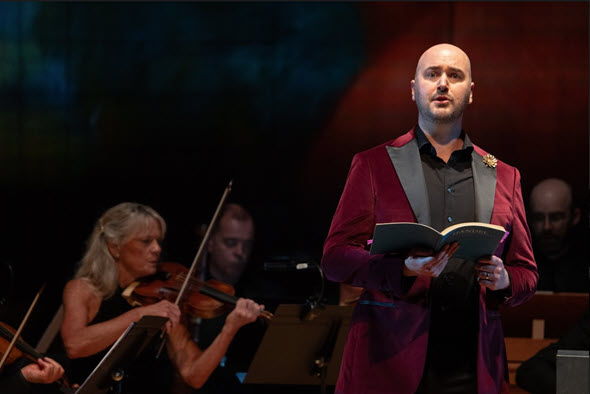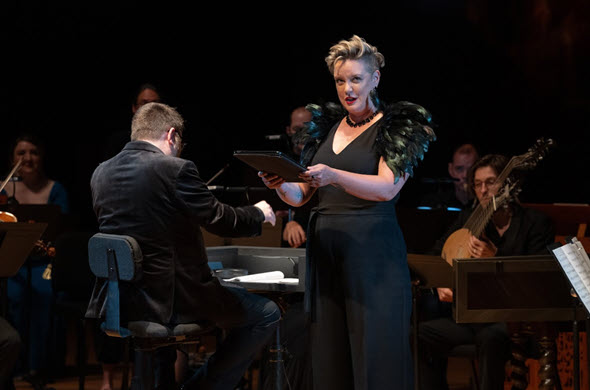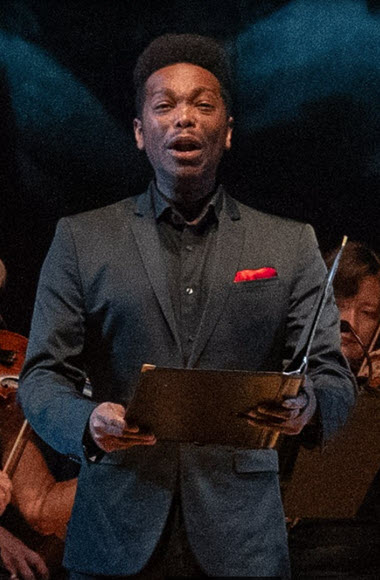Haymarket Opera closes out its spring season with early Handel oratorio ‘La Resurrezione’

Evocative projections adorned Haymarket’s production of Handel’s oratorio “La Resurrezione.” (Elliot Mandel photos)
Review: Haymarket Opera Company production of Handel’s oratorio “La Resurrezione” on June 14 at DePaul University.
By Lawrence B. Johnson
In September, the ever-enterprising and always intriguing Haymarket Opera Company will return to its home base, Jarvis Opera Hall at DePaul University, to do what it does with unsurpassed style and relentless devotion: Baroque opera. On tap is Handel’s “Tamerlano,” an exotic medieval tale first produced in London exactly 300 years ago but apparently never before seen in Chicago.
Rarities, albeit not exactly operatic, have filled Haymarket’s spring season — in March the first performance in 300 years of Maria Margherita Grimani’s 1715 melodrama “The Beheading of John the Baptist” (or “La decollazione di San Giovanni Battista”) and on June 14 an oratorio from Handel’s youthful Italian sojourn, “La Resurrezione.” The latter brought two unusual moves by Haymarket, the importation of someone other than founding artist director Craig Trompeter to conduct and a visiting star turn by Chicago violin virtuoso Rachel Barton Pine as concertmaster and spotlighted soloist.
As the title suggests, “La Resurrezione” is a religious work with, well, a capital R. We might add one more R-word: rapture. Four of the five characters – personas might be a better word – are concerned not with any interpersonal issues among themselves but singularly focus on the re-emergence of Jesus from death. The fifth character, the only one with anything like a dramatic profile, is Lucifer. He is self-interested and skeptical right up to the point where the Christian victory sends him back to hell.
The conventional image of Handel, middle-aged, fleshy and adorned with a proper peruque, hardly fits the idea of a youth of 23 soaking up the musical riches of Italy, the Handel who composed “La Resurrezione” in 1708. The established master in London 15 years later, spinning out “Tamerlano,” is more our guy. But all of Handel’s prodigious gifts, however formative, are on display in “La Resurrezione,” which unfolds in two parts: the Eve of Easter and Holy Sunday. Except for a couple of minor choruses, satisfied here by the five singers joining voices, the oratorio plays out strictly as a series of solo arias. And already we hear the composer’s staggering lyrical gift, a seemingly effortless and expressively sure consistency that draws immediate comparison with Mozart.
Yet hardly less bountiful is the orchestral music and, pointedly, the brilliant solo underpinning for violin and viola da gamba or cello. Here, Trompeter took up his wonted role on gamba (and cello) with Pine providing all the needed spark of the lead violin part. As ever, the rest of the band acquitted itself splendidly.
In a cast where an angel and two women outnumbered dread Lucifer and his one male counterpart, John the Evangelist, it was tenor Scott J. Brunscheen’s clarion delivery as John that all but stole the show. The affecting simplicity and directness of his singing, combined with generous vocal quality, lent credence to John’s protestations of faith. On the opposing side, bass-baritone Jonathan Woody’s dark sound – all char and hot cinder – wreathed Lucifer in a mildly amusing aura of evil. Nor could one miss his rakish ID, a thin banner of blazing red hanky peeking from his jacket pocket.
Speaking of amusement, I couldn’t help taking a wry view of soprano Sarah Brailey’s black, feathery gown – not a costume, to be sure – as the Angel, Lucifer’s divine opposite. Brailey sang with great warmth and displayed the polished agility fundamental to negotiating any major vocal assignment in Handel. Still, I can imagine some devout Handelian in the audience, age 6, tugging on the sleeve next to her: “Mommy, why is the angel wearing black?”
As the two female followers of Jesus, soprano Hannah De Priest’s Mary Magdalene and mezzo-soprano Quinn Middleman’s Mary Cleophas presented striking vocal contrasts and thus clear identities, the former bright and buoyant and the latter exuding a dusky, voluptuous texture.
Guest conductor Christian Curnyn, a British Baroque specialist, led with understated efficiency. Tempos were lively, instrumental voicings clear and orchestral accompaniments well proportioned to the sung lines, an altogether charming and vital conception of a deceptively rigorous work.
While the production was not staged in any theatrical sense, it did gain some evocative enhancement, even a sense of occasion, from stylized projections of Baroque paintings and other imagery designed by Camilla Tassi. It was a single performance, commonly called a one-off, and also likely once in a lifetime.
This is a great part of what makes Haymarket such a Chicago treasure: Whether it’s one performance or a run, the endeavor is always serious musically, artistically, creatively. Handel at 23. What a marvelous snapshot.





